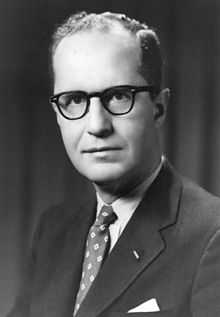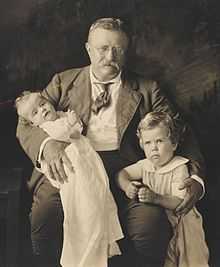Kermit Roosevelt, Jr.
- For other persons with the same name, see Kermit Roosevelt (disambiguation).
| Kermit Roosevelt, Jr. | |
|---|---|
 | |
| Born |
February 16, 1916 Buenos Aires, Argentina |
| Died |
June 8, 2000 (aged 84) Cockeysville, Maryland |
Kermit Roosevelt, Jr. (February 16, 1916 – June 8, 2000), was a political action officer of the Central Intelligence Agency's (CIA) Directorate of Plans who coordinated the Operation Ajax, which aimed to orchestrate a coup d'état against Iran's prime minister, Mohammed Mosaddeq, and return Mohammad Reza Pahlavi, the Shah of Iran, to Iran's Sun Throne in August 1953. He was also the grandson of US president Theodore Roosevelt.
Biography

Kermit Roosevelt, Jr. was born in Buenos Aires in 1916, the eldest son of Kermit Roosevelt and Belle Wyatt Willard. Kermit, Sr. was assistant manager for the Buenos Aires branch of the National City Bank. He had two brothers, Joseph Willard Roosevelt and Dirck Roosevelt, and a sister, Belle Wyatt Roosevelt. Kermit Roosevelt, Jr. graduated from Groton School and Harvard University.
When Kermit, Jr. was 27, his father, a man who tended to drink heavily, committed suicide in Alaska where he had been stationed as an intelligence officer with the U.S. Army.
Kermit Roosevelt, Jr. married Mary Lowe "Polly" Gaddis in 1937. They had three sons and a daughter. His eldest son, Kermit Roosevelt III (born April 7, 1938), graduated from Groton School in the class of 1956 and is a Washington D.C. attorney. Another son, Mark Roosevelt (born 1955) is President of Antioch College. His other son is Jonathan Roosevelt and his daughter is Anne Mason of Bethesda.[1]
Roosevelt's last days were spent at a retirement community in Cockeysville, Maryland.[2]
Middle East political activity
In the late 1940s he was on the advisory board of the Institute of Arab American Affairs Inc. The Institute published an article by him in Foreign Affairs in pamphlet form that made the argument that "US support of Zionism will be detrimental to long term US interests in the Middle East."[3]
In a further effort to prevent the partition of Palestine into exclusive and separate Jewish and Arab states, Roosevelt together with Virginia Gildersleeve founded the Committee for Justice and Peace in the Holy Land in 1948, and served as the Committee's executive director.[4]
In 1951, Roosevelt, together with Dorothy Thompson and a group of 24 American educators, theologians, and writers including Harry Emerson Fosdick and Virginia Gildersleeve founded the American Friends of the Middle East.[5] Roosevelt served the AFME as executive secretary for a time.[6]
Head of Operation Ajax
By the early 1950s, Kermit Roosevelt, Jr. was a senior officer in the CIA's Middle Eastern division. At that time, there was a political crisis centered in Iran that commanded the focused attention of British and American intelligence outfits. In 1951, the Iranian parliament, under the leadership of the nationalist movement of Dr. Mohammed Mossadegh, voted unanimously to nationalize the oil industry. This shut out the immensely profitable Anglo-Iranian Oil Company (AIOC), which was a pillar of Britain's economy and political clout. A month after that vote, Mossadegh was elected prime minister of Iran.[7]
In response to nationalization, Britain placed an embargo on Iranian oil exports, which worsened the already fragile economy. Neither the AIOC nor Mossadegh was open to compromise in this period, with Britain insisting on a restoration of the AIOC and Mossadegh willing only to negotiate the terms of its compensation for lost assets. U.S. President Harry S. Truman ruled out joining Britain in a coup against Mossadegh, and Britain felt unable to act without American cooperation, particularly since Mossadegh had shut down their embassy in 1952.[7] Truman's successor, President Dwight D. Eisenhower, was persuaded by anti-communist arguments that there was potential for Iran's Communist Tudeh Party to capitalize on political instability and assume power, aligning Iran and its immense oil resources with the Soviet bloc. Coup plans which had stalled under Truman were revived by an eager intelligence corps, with powerful aid from the brothers John Foster Dulles (Secretary of State) and Allen Welsh Dulles (Director of Central Intelligence), after Eisenhower's inauguration in 1953.[7]
According to Roosevelt, he slipped across the border under his CIA cover as "James Lockridge" on June 19, 1953. He was put up in the capital, Tehran, in a place rented by British intelligence. As Mr. Lockridge, he became a regular at the Turkish Embassy where he played tennis. No one suspected that "Mr. Lockridge" was the grandson of the 26th US President but he came close to blowing his cover. When playing tennis and making some frustrating mistake he would cry out, "Oh Roosevelt!" Puzzled by this, his friends asked him about this interesting way of expressing his annoyance with his game. He explained that as a loyal member of the Republican Party back in the states, that every Republican had nothing but scorn and hatred for Franklin D. Roosevelt and that he despised the man so much that he took to using FDR's name as a curse.[8]
Under Roosevelt's direction, the CIA and British intelligence funded and led a campaign of black propaganda and bribery leading to a coup d'etat to overthrow Mossadegh with the help of military forces loyal to the Shah in Operation Ajax.[9] The plot hinged on orders signed by the Shah to dismiss Mossadegh as prime minister and replace him with General Fazlollah Zahedi, a choice agreed on by the British and Americans.
Despite the high-level coordination and planning, the coup faltered initially and the Shah fled Iran. After a brief exile in Italy, however, the Shah was brought back again, this time through a second coup which was successful.
In his book All the Shah's Men: An American Coup and the Roots of Middle East Terror, The New York Times reporter Stephen Kinzer reported[7] that the CIA ordered Roosevelt to leave Iran. Roosevelt ignored the order and, instead organized a second coup, this one successful. The deposed Mossadegh was arrested, given a show trial, and placed in solitary confinement for three years in military prison, followed by house arrest for life. Zahedi was installed to succeed prime minister Mossadegh.
After that coup, Kinzer reported that the Shah said to Roosevelt, "I owe my throne to God, my people, my army—and to you."[7]
Roosevelt tells his story
Twenty-six years later, Kermit Roosevelt took the unusual step of writing a book about how he and the CIA carried out the operation. He called his book Countercoup to press home the idea that the CIA coup was staged only to prevent a takeover of power by the Iranian Communist Party (Tudeh) closely backed by the Soviet Union. He also may have meant to imply that the exile of the Shah constituted the initial coup, and that he was merely restoring the rightful leader to power. Roosevelt submitted his manuscript to the CIA for pre-publication approval, and the agency proposed various alterations: "Basically, Roosevelt has reflected quite faithfully the changes that we suggested to him. This has become, therefore, essentially a work of fiction."[10]
In 2003, William Blum, in Killing Hope: US Military and CIA Interventions Since World War II criticized Roosevelt for providing no evidence when he "argu[ed] that Mossadegh had to be removed to prevent a communist takeover" of Iran.[11] Blum noted that while Roosevelt kept repeating how Mossadegh was a danger due to his seizure of the oil industry and his other Socialist reforms as well as his cooperation with the Tudeh Party, Mossadegh's role was much more nuanced.[11] This view was shared by many in the intelligence community, although most notably the head of the CIA station in Iran resigned rather than participate in the coup. Many outside the intelligence community, including some in the Truman administration, had felt that Mossadegh should have been kept in power to prevent a Communist takeover.[11]
Some scholars have criticized Countercoup as "self-aggrandizing" and overstating the American role in the events of 1953. In his 2010 book, Iran and the CIA, the Fall of Mosaddeq Revisited, Swiss-Iranian scholar Darioush Bayandor presented extensive archival material from released US State Department files as well as the CIA's own internal account of the event contradicting Roosevelt's narrative in the counter-coup. In the same vein American scholar Ray Takeyh wrote in 2014, "Contrary to Roosevelt's account, the documentary record reveals that the Eisenhower administration was hardly in control and was in fact surprised by the way events played out."[12] Abbas Milani maintains the same line, writing, "Roosevelt's memoir inflated his own and, in turn, America's centrality to the coup. He tells the story with the relish of a John le Carré knock-off. ... Eisenhower, for one, considered reports like this to be the stuff of 'dime novels.'"[13]
Bibliography
- Arabs, Oil, and History: The Story of the Middle East (1949, reprint 1969, Kennikat Press, 1969) ISBN 0-8046-0532-7.
- Countercoup: The Struggle for the Control of Iran (McGraw-Hill, 1979) ISBN 0-07-053590-6.
- Roosevelt, Kermit. "Propaganda Techniques of the English Civil Wars – and the Propaganda Psychosis of Today." Pacific Historical Review (University of California Press) 12, no. 4 (December 1943): 369–379.
Books
- Meyer, Karl and Shareen Blair Brysac, Kingmakers: the Invention of the Modern Middle East, W.W. Norton, 2008. ISBN 978-0-393-06199-4.
- Kinzer, Stephen (2004). All the Shah's Men|All The Shah's Men: An American Coup and the Roots of Middle East Terror]] John Wiley & Sons. ISBN 0-471-26517-9.
- Bayandor, Darioush (2010), Iran and the CIA; the Fall of Mosaddeq Revisited, Palgrave. ISBN 978-0-230-57927-9
- Kapuściński, Ryszard (1982). Shah of Shahs]]. Vinage. ISBN 0-679-73801-0
- Abrahamian, Ervand (2013). The Coup: 1953, the CIA, and the Roots of Modern U.S.-Iranian Relations, The New Press. ISBN 978-1-59558-826-5.
References
- ↑ "Kermit Roosevelt, 84, TR's grandson." Mark Ribbing and Jacques Kelly. Baltimore Sun. Local ,4B. June 10, 2000.
- ↑ Molotsky, Irvin (10 June 2000). "Kermit Roosevelt, Leader of C.I.A. Coup in Iran, Dies at 84". nytimes.com. Retrieved 19 March 2015.
- ↑ Partition of Palestine: A Lesson in Pressure Politics
- ↑ Jews Against Zionism, Thomas A. Kolsky, Temple University Press, 1992, pp. 181–2.
- ↑ Miller, Robert Moats (1985). Harry Emerson Fosdick: Preacher, Pastor, Prophet. Oxford [Oxfordshire]: Oxford University Press. p. 192. ISBN 0-19-503512-7.
- ↑ Merkley, Paul (2001). Christian Attitudes towards the State of Israel. Montreal: McGill-Queen's University Press. pp. 6–8. ISBN 0-7735-2188-7.
- ↑ 7.0 7.1 7.2 7.3 7.4 How to Overthrow A Government Pt. 1: The 1953 U.S. Coup in Iran, Democracynow.org, March 5, 2004
- ↑ Roosevelt, Kermit, Jr. (1979). Countercoup, the Struggle for Control of Iran McGraw Hill/New York.
- ↑ New York Times Library. Iran/CIA Index.
- ↑ Byrne, Malcolm (12 May 2014). "Iran 1953: The Strange Odyssey of Kermit Roosevelt's Countercoup". National Security Archive. Retrieved 19 March 2015. See Document 17.
- ↑ 11.0 11.1 11.2 William Blum. Killing Hope: US Military and CIA Interventions Since World War II. Zed Books Ltd; 2nd edition. 2003. p. 66.
- ↑ Takeyh, Ray (July–August 2014). "The Truth About the CIA and Iran". Foreign Affairs. Retrieved 11 August 2014.
- ↑ Milani, Abbas (December 8, 2009). "The Great Satan Myth". The New Republic. Retrieved 11 August 2014.
External links
- The Secret CIA History of the Iran Coup – The National Security Archive
- What Kermit Roosevelt Jr. Didn't Say – In Memory of August 19, 1953
- 50 Years After the CIA’s First Overthrow of a Democratically Elected Foreign Government
- Partition of Palestine: A Lesson in Pressure Politics an anti-Zionist pamphlet written by Kermit Roosevelt
- Time Obituary from 2000
- Video of Roosevelt, talking about the operation on YouTube
- NNDB profile
Listening
- Interview with Stephen Kinzer about Iran coup, from NPR Fresh Air program